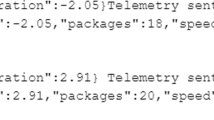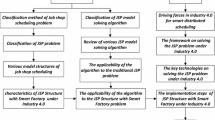Abstract
The characteristics of scheduling tasks in the real world is a dynamic and challenging issue as the processes and the companies involved may change from time to time. For small flexible enterprises to respond to business opportunities, an effective scheme to facilitate dynamic coalition, share the core competencies and resources and support inter-enterprise collaboration must be developed. Although multi-agent systems (MAS) provide a paradigm for modeling these characteristics, scheduling tasks in MAS is a complex problem due to the computational complexity involved, distributed architecture for scheduling tasks by individual agents and dependency of different agents’ workflows. How to develop a problem solver that can be applied in MAS to achieve coherent and consistent workflow schedules that can meet a customer’s order is an important issue. In this paper, we propose a solution methodology for scheduling workflows in MAS. Our solution combines the multi-agent system architecture to dynamically discover services, workflow and activity models to specify the capabilities of agents, contract net protocol to facilitate negotiation and coordination of agents and optimization theories to optimize the cost for fulfilling an order. A problem solver for scheduling tasks in MAS has been implemented. An application scenario has also been provided to verify our solution methodology.















Similar content being viewed by others
References
Petrie C, Bussler C (2003) Service agents and virtual enterprises: a survey. Internet Comput 7(4):68–78
Camarinha-Matos LM, Pantoja-Lima C (2001) Cooperation coordination in virtual enterprises. J Intell Manuf 12(2):133–150
Hsieh FS, Lin JB (2012) Context-aware workflow management for virtual enterprises based on coordination of agents. J Intell Manuf. doi:10.1007/s10845-012-0688-8
Hsieh FS (2009) Developing cooperation mechanism for multiagent systems with Petri nets. Eng Appl Artif Intell 22(4–5):616–627
Afsarmanesh H, Analide C (2009) Virtual enterprises—methods and ap-proaches for coalition formation. Int J Prod Res 47(17):4655–4659
Camarinha-Matos LM, Oliveira A, Sesana M, Galeano N, Demsar D, Baldo F, Jarimo T (2009) A framework for computer-assisted creation of dynamic virtual organizations. Int J Prod Res 47(17):4661–4690
Hoffner Y, Field S, Grefen P, Ludwig H (2001) Contract-driven creation and operation of virtual enterprises. Comput Netw 37(2):111–136
Hsieh FS (2008) Holarchy formation and optimization in holonic manufacturing systems with contract net. Automatica 44(4):959–970
Camarinha-Matos LM, Cardoso T (1999) Selection of partners for a virtual enterprise. In: Camarinha-Matos LM, Afsarmanesh H (eds) Pro-VE’99 book, infrastructure for virtual enterprises: networking industrial enterprises. Kluwer Academic, Boston Dordrecht, pp 259–278
Hsieh FS, Lin JB (2012) Virtual enterprises partner selection based on reverse auction. Int J Adv Manuf Technol 62(5–8):847–859
Soares AL, Azevedo AL, De Sousa JP (2000) Distributed planning and control systems for the virtual enterprise: organizational requirements and development life-cycle. J Intell Manuf 11(3):253–270
Grefen P, Mehandjiev N, Kouvas G, Weichhart G, Eshuis R (2009) Dynamic business network process management in instant virtual enterprises. Comput Ind 60(2):86–103
Hsieh FS, Chiang CY (2011) Collaborative composition of processes in holonic manufacturing systems. Comput Ind 62(1):51–64
Hsieh FS (2010) Design of reconfiguration mechanism for holonic manufacturing systems based on formal models. Eng Appl Artif Intell 23(7):1187–1199
Hsieh FS (2009) Dynamic composition of holonic processes to satisfy timing constraints with minimal costs. Eng Appl Artif Intell 22(7):1117–1126
Jagdev H, Vasiliu L, Browne J, Zaremba M (2008) A semantic web service environment for B2B and B2C auction applications within extended and virtual enterprises. Comput Ind 59(8):786–797
Wang D, Nagalingam SV, Lin GCI (2007) Development of an agent-based virtual CIM architecture for small to medium manufacturers. Robot Comput-Integr Manuf 23(1):1–16
Smith RG (1980) The contract net protocol: high-level communication and control in a distributed problem solver. IEEE Trans Comput 29(12):1104–1113
McFarlane DC, Bussmann S (2000) Developments in holo-nic production planning and control. Int J Prod Plann Control 11(6):522–536
Parunak HVD (1987) Manufacturing experiences with the contract net. In: Huhns M (ed) Distributed artificial intelligence. Pitman, London, pp 285–310
Ramos C (1996) A holonic approach for task scheduling in manufacturing systems. In: Proceedings of the 1996 IEEE international conference on robotics and automation, pp 2511–2516
Brennan RW, Norrie DH (2001) Evaluating the performance of reactive control architectures for manufacturing production control. Comput Ind 46(3):235–245
Neligwa T, Fletcher M (2003) An HMS operational model. In: Deen SM (ed) Agent-based manufacturing: advances in the holonic approach. Springer, Berlin, pp 163–191
Sandholm TW (1998) Contract types for satisfying task alloca-tion: I theoretical results. In: AAAI spring symposium series: satisficing models, Stanford University, CA, March, pp 68–75
van der Aalst WMP (1998) The application of Petri nets to workflow management. J Circuits Syst Comput 8(1):21–66
van der Aalst WMP, Kumar A (2001) A reference model for team-enabled workflow management systems. Data Knowl Eng 38(3):3355–3363
Weske M, van der Aalst WMP, Verbeek HMW (2004) Advances in business process management. Data Knowl Eng 50(1):1–8
Hsieh FS, Lin JB (2014) Development of context-aware workflow systems based on Petri net markup language. Comput Stand Interfaces 36(3):672–685
Billington J, Christensen S, van Hee K, Kindler E, Kummer O, Petrucci L, Post R, Stehno C, Weber M (2003) In: The Petri net markup language: concepts, technology, and tools. Lecture notes in computer science, vol 2679, pp 483–505
Java agent development framework. http://jade.tilab.com/
Murata T (1989) Petri nets: properties, analysis and applications. Proc IEEE 77(4):541–580
Karageorgos A, Mehandjiev N, Weichhart G, Hämmerle A (2003) Agent-based optimisation of logistics and production planning. Eng Appl Artif Intell 16(4):335–348
Hsieh FS, Lin JB (2013) A self-adaptation scheme for workflow management in multi-agent systems. J Intell Manuf. doi:10.1007/s10845-013-0818-y
Leitão P, Restivo F (2006) ADACOR: a holonic architecture for agile and adaptive manufacturing control. Comput Ind 57(2):121–130
Edmonds J, Karp RM (1972) Theoretical improvements in algorithmic efficiency for network flow problems. J ACM 19(2):248–264
Polyak BT (1969) Minimization of unsmooth functionals. USSR Comput Math Math Phys 9:14–29
Ferber J (1999) Multi-agent systems, an introduction to distributed artificial intelligence. Addison Wesley, Reading
Nilsson NJ (1998) Artificial intelligence: a new synthesis. Morgan Kaufmann, San Francisco
Russel SJP (2006) Norvig, artificial intelligence—a modern approach, 2nd edn. Pearson Education Asia Limited, New York
Conry SE, Kuwabara K, Lesser VR, Meyer RA (1991) Multistage negotiation for distributed constraint satisfaction. IEEE Trans Syst Man Cybern 21(6):1462–1477
Ameri F, McArthur C (2013) A multi-agent system for autonomous supply chain configuration. Int J Adv Manuf Technol 66(5–8):1097–1112
Long Q, Lin J, Sun Z (2011) Modeling and distributed simulation of supply chain with a multi-agent platform. Int J Adv Manuf Technol 55(9–12):1241–1252
Zhang WJ, Xie SQ (2007) Agent technology for collaborative process planning: a review. Int J Adv Manuf Technol 32(3–4):315–325
Merdan M, Moser T, Vrba P, Biffl S (2011) Investigating the robustness of re-scheduling policies with multi-agent system simulation. Int J Adv Manuf Technol 55(1–4):355–367
Thomas A, Trentesaux D, Valckenaers P (2012) Intelligent distributed production control. J Intell Manuf 23(6):2507–2512
Radakovič M, Obitko M, Mařík V (2012) Dynamic explicitly specified behaviors in distributed agent-based industrial solutions. J Intell Manuf 23(6):2601–2621
Sabar M, Montreuil B, Frayret J-M (2012) An agent-based algorithm for personnel shift-scheduling and rescheduling in flexible assembly lines. J Intell Manuf 23(6):2623–2634
Aissani N, Bekrar A, Trentesaux D, Beldjilali B (2012) Dynamic scheduling for multi-site companies: a decisional approach based on reinforcement multi-agent learning. J Intell Manuf 23(6):2513–2529
Graves SC (1981) A review of production scheduling. Oper Res 29(4):646–675
Nedić A, Bertsekas D (2001) Convergence rate of incremental subgradient algorithm. Stoch Optim Algorithms Appl 54:223–264
Fisher ML (2004) Lagrangian relaxation method for solving integer programming problems. Manag Sci 50(12):1861–1871
Akkiraju R, Keskinocak P, Murthy S, Wu F (2001) An agent-based approach for scheduling multiple machines. Appl Intell 14(2):135–144
Choi S, Baik M, Gil J, Jung S, Hwang C (2006) Adaptive group scheduling mechanism using mobile agents in peer-to-peer grid computing environment. Appl Intell 25(2):199–221
Mouhoub M, Sukpan A (2012) Managing dynamic CSPs with preferences. Appl Intell 37(3):446–462
Su C, Li H (2012) An affective learning agent with Petri-net-based implementation. Appl Intell 37(4):569–585
Günay A, Yolum P (2013) Constraint satisfaction as a tool for modeling and checking feasibility of multiagent commitments. Appl Intell 39(3):489–509
Li C, Li L, Luo Y (2013) Agent based sensors resource allocation in sensor grid. Appl Intell 39(1):121–131
Acknowledgements
This paper is currently supported in part by National Science Council of Taiwan under Grant NSC102-2410-H-324-014-MY3.
Author information
Authors and Affiliations
Corresponding author
Appendices
Appendix A: Structure of workflows

Appendix B: Structure of resource activities

Rights and permissions
About this article
Cite this article
Hsieh, FS., Lin, JB. A dynamic scheme for scheduling complex tasks in manufacturing systems based on collaboration of agents. Appl Intell 41, 366–382 (2014). https://doi.org/10.1007/s10489-014-0521-5
Published:
Issue Date:
DOI: https://doi.org/10.1007/s10489-014-0521-5




